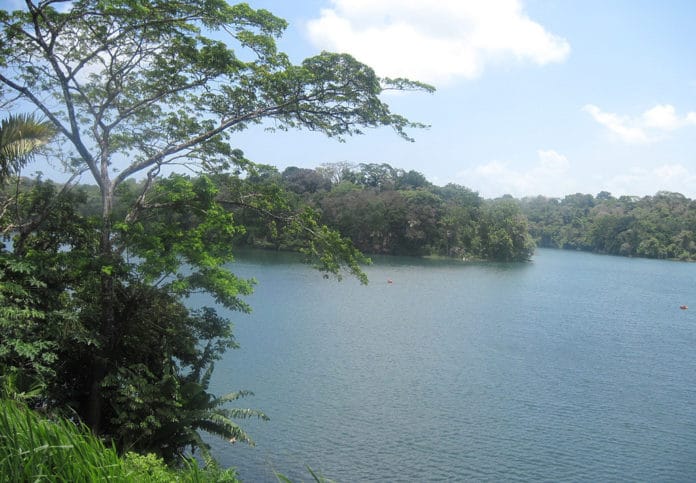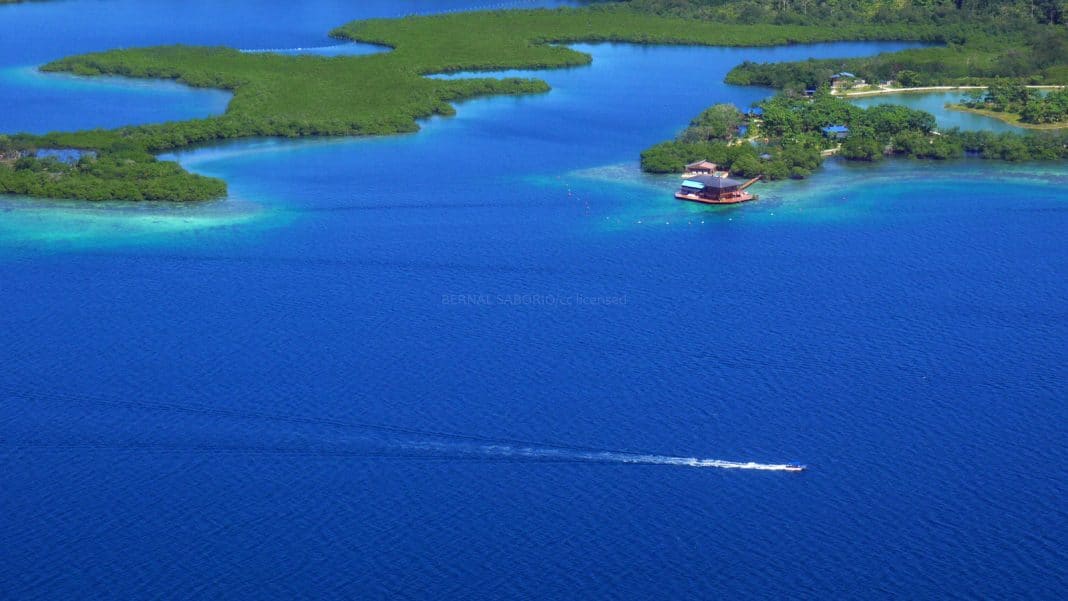Charles Davis at DeeperBlue reviews the diving in Panama.
You have your heart set on a Pacific destination and some dives with humpback whales. Your dive buddy, they want to try some fresh water diving. The significant others? It is a Caribbean beach for them or you all stay home. We all know, that the significant others will win out. Still, you really wanted that dive with humpbacks and your dive buddy want a freshwater dive.
There is a destination that can meet everyone’s desire, Panama. The Isthmus of Panama, historically the Isthmus of Darien, is located where the continents of North and South America meet. The mountain range at the southern edge of the country of Panama is the accepted division point. The Caribbean Sea is off one coast and the Pacific Ocean off the other coast. The isthmus is 676 km (420 miles) long and the distance between coast as little as 50 km (31 miles). Near this narrowest point, the Panama Canal was built. Colón is at the Caribbean side of the canal, and Panama City is at the Pacific Ocean side of the canal. In addition to the canal, a superhighway and a once-daily train can take you between the cities. Bus service takes about an hour and 15 minutes to 2 hours each way, driving yourself should take an hour. Some dive shops can provide the transportation and even offer dive trips diving both oceans.
Freshwater Diving in Panama
Panama has dozens of lakes and about 500 rivers. However, the major freshwater diving attraction is Gatun Lake. Gatum Lake is the second largest man-made lake in North America, behind Lake Mead in the United States. The lake was created during the building of the Panama Canal by damming the Chagres River. Ships using the canal today will transverse 33 kilometers (21 mi) of the lake towards their next lock. Like Lake Mead and the Hoover Dam, when the dam was closed on the Chagres River, the water rose covering everything behind it up to the dam level. This included small villages, and construction equipment left behind. Some hilltops were higher than the dam, leaving them as islands in the new lake.

Most of the border around the lake is an undisturbed jungle. These shorelines as well as the islands are home to abundant wildlife. Nature lovers find the area a major draw for the country. Scuba divers will find the underwater terrain very interesting as they explore items left behind a 100 years ago. While not as varied as the coast, the lake does have substantial marine life. While the lake was filled by damming a freshwater river and its tributaries, the opening and closing of the locks have allowed some salt water to contaminate the lake.
Visibility in the lake is not great and depending on the distance from the ship channel can be very poor.
Panama’s Caribbean Coast
There are many places you can dive along the Caribbean coast, but two, the Bocas del Toro Archipelago and the Portobelo National Park, top the list. The Bocas del Toro Archipelago is a portion of the Bocas del Toro Province in the north of Panama. Bocas Town on the Isla Colon is the provincial capital and has a small domestic airport. The archipelago is also easily reached from the mainland by water ferries. The province is only about 40 kilometers/ 24 miles from the Costa Rico border. The Talamanca Range-La Amistad Reserves / La Amistad National Park is a UNESCO World Heritage Site that crosses the Costa Rico/ Panama border. The heritage site has both land and marine portions. One of the marine portions is the Isla Bastimentos National Marine Park in the Bocas del Toro Archipelago.
One of the citations in the UNESCO inscriptions talks of the diverse marine life of the archipelago. It is among the highest in the Caribbean. Another of the citations concerns the watershed. The area has a fully intact watershed which means there is little or no runoffs to impact diving visibility. Diving is available in the Bocas del Toro Archipelago year round. December through March is the areas high season but it also the wettest time of year to visit. Some of the dive sites are not dived due to surf conditions. Great for surfing, not that much for diving. However, dive sites on the leeward site are still calm. September and October are the low season for tourist but offer the best diving.
Portobelo National Park is located to the east of the City of Colon, the Caribbean side of the Panama Canal. Portobelo or Port Beautiful is said to be named by Christopher Columbus in 1502 and the first Spanish settlement was established there in 1597. Portobelo became a very important transfer point for Peruvian silver and in some years was involved in the trade from Manila. Today the National Park has five 17th century Spanish forts. The coastline presents a number of different habitats and these, in turn, offer the scuba diver a host of choices.
The coral reefs are in excellent shape, however, there are concerns that they are being pressured by onshore development. Also many will say that the number of fish is decreasing. Most divers, who have not been there before, will find the diving excellent on the reefs. The reefs have over 50 species of coral, hundreds of species of reef fish, the endangered hawksbill turtle among others turtles and a range of pelagic marine life. There are also shallow lagoons and mangrove forest.
Pacific Coast of Panama
The Pacific coast of Panama also has diving in two large areas, The Gulf of Chiriqui and the Gulf of Panama and its smaller area the Bay of Panama. It is interesting to note that, while we normally think of the separation between the Pacific Ocean and the Caribbean Sea portion of the Atlantic Ocean as an east/west orientation, in Panama it is a north/south orientation. The Gulf of Mexico and the Caribbean Sea, both part of the Atlantic Ocean is off Mexico’s east coast. The Pacific is off the west coast. However, in Panama, most of the Caribbean coastline is the north coast, while the Pacific Ocean is off the south coast. Coiba National Park located in the Gulf of Chiriqui is off the southwest coast of Panama, and is south and slightly east of the Bocas del Toro Archipelago on the other side of Panama. Coiba National Park is another UNESCO site and includes Coiba Island, 38 smaller islands and the surrounding marine areas.
One of the reasons for the inclusion of the park as a UNESCO site is the diversity found here. There are over 700 species of reef fish, however, they represent different eco-spheres. Some of the areas of the gulf have traits of a tropical continental zone, relatively calm waters, variety of marine life and tropical reefs. While others have an oceanic zone, typical of what we think of when we think of the deep oceans. In the Pacific’s case strong currents and colder water. Here you will see in the proper season humpback whales, whale sharks, sharks and occasionally orcas.
Diving at Coiba National Park can allow you to dive in both types of conditions often in the same day.
The Archipelago de las Perlas or The Pearl Islands has about 250 islands, most of them small and uninhabited, located in the Gulf of Panama. Contadora Island is the archipelago’s main island and has the only airport. Flying time from Panama city is only 15 minutes. You can also take a ferry in as fast as an hour, or a more leisurely 2 hours. Diving here you can expect to see humpback whales and whale sharks among other pelagics. This is also a great area for drift dives. A word of caution, many of the dive sites here are for experienced divers. Conditions can change rapidly and the tidal range can be over 18 feet/ 6 meters. It is very important you dive with someone experienced with the local area and the tide tables.
Overall, you will find the diving in Panama outstanding. While each destination within the country offers different diving opportunities, it is common for divers to visit more than one destination in a trip. Where would you choose?
